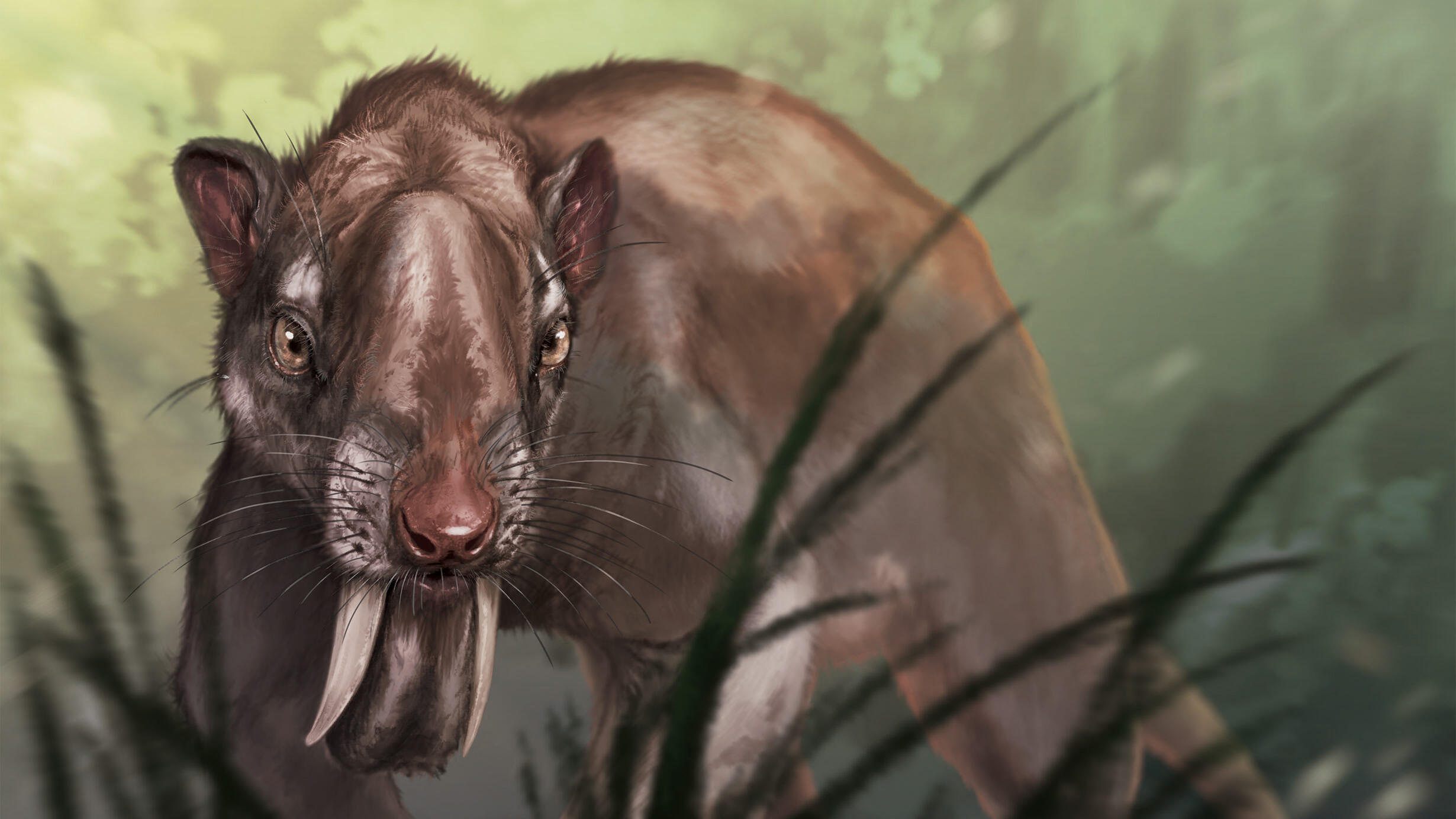 A reconstruction of Thylacosmilus atrox.
A reconstruction of Thylacosmilus atrox. © Jorge Blanco
Thylacosmilus was an outlier. The carnivorous mammal, which lived in South America until its extinction about 3 million years ago, had huge canines that grew rootwards, eventually extending almost to the rear of the skull—earning it its popular name as the “marsupial sabertooth.”
Perhaps more significantly, the skull shape required to accommodate these teeth caused its eyes to be wide-set, like those of horses and other herbivores, an unusual adaptation for a meat-eater that hunted prey.
The skulls of carnivores typically have forward-facing eye sockets, or orbits—think cats and dogs—which ensure stereoscopic (3D) vision, a useful adaptation for judging the position of prey before pouncing.
By contrast, the laterally facing orbits of Thylacosmilus, a member of Sparassodonta, a group related to living marsupials, did not allow visual fields to overlap sufficiently for the brain to integrate them in 3D.
So how did this hypercarnivore maintain a diet estimated to have consisted of at least 70 percent meat? A team of researchers from the American Museum of Natural History and the Instituto Argentino de Nivología, Glaciología, y Ciencias Ambientales in Mendoza, Argentina, set out to find out. Their results are published today in the journal Communications Biology.
Lead author Charlène Gaillard, a Ph.D.-degree candidate at the Instituto Argentino de Nivología, Glaciología, y Ciencias Ambientales (INAGLIA), used CT scanning and 3D virtual reconstructions to assess orbital organization in a number of fossil and modern mammals and determine how the visual system of Thylacosmilus compared to those in other carnivores or other mammals in general.
“No room was available for the orbits in the usual carnivore position on the front of the face,” said Gaillard.
But good stereoscopic vision also relies on the degree of frontation, a measure of how the eyeballs are situated within the orbits, and here Thylacosmilus did an about-face.
"Thylacosmilus was able to compensate for having its eyes on the side of its head by sticking its orbits out somewhat and orienting them almost vertically, to increase visual field overlap as much as possible,” said co-author Analía M. Forasiepi, also at INAGLIA and a researcher in CONICET, the Argentinian science and research agency. “Even though its orbits were not favorably positioned for 3D vision, it could achieve about 70 percent of visual field overlap—evidently, enough to make it a successful active predator.”
Lateral displacement of the orbits was not the only cranial modification that Thylacosmilus developed to accommodate its canines while retaining other functions. Placing the eyes on the side of the skull brings them close to the temporal chewing muscles. To accommodate this, some mammals, including primates, have developed a bony structure that closes off the eye sockets from the side. Thylacosmilus did the same thing—another example of convergence among unrelated species.
“Compensation appears to be the key to understanding how the skull of Thylacosmilus was put together,” said co-author and Museum mammologist Ross D. E. MacPhee. “The odd orientation of the orbits in Thylacosmilus actually represents a morphological compromise between the primary function of the cranium, which is to hold and protect the brain and sense organs, and a collateral function unique to this species, which was to provide enough room for the development of the enormous canines.”
This leaves a final question: What purpose would have been served by developing huge, ever-growing teeth?
“To look for clear-cut adaptive explanations in evolutionary biology is fun but largely futile,” says Forasiepi. “One thing is clear: Thylacosmilus was not a freak of nature, but in its time and place it managed, apparently quite admirably, to survive as an ambush predator. We may view it as an anomaly because it doesn’t fit within our preconceived categories of what a proper mammalian carnivore should look like, but evolution makes its own rules.”